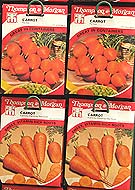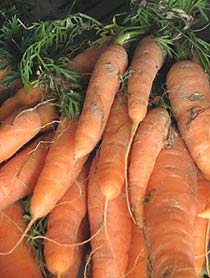Carrot - How to sow and grow a crop of carrots
CARROT VARIETIES
Short Stump Carrots
Amsterdam Forcing
French Forcing
Early Gem
Champion Scarlet Horn
Nantes Tip Top
Early Nantes

Intermediate Stump Carrots
Berlicum Cylinder
Scarla
Favourite
Intermediate Tapering Carrots
Autumn King
Jame's Intermediate
Long Tapering Carrots
New Red Intermediate
St Valery
Long Stump Carrots
Scarlet Perfection
VEGETABLE PAGES
SOCIETIES
CARROT
 Carrots
are one of everyone's favourite vegetables.
Carrots
are one of everyone's favourite vegetables.
Valuable for their high vitamin A content, a carrot crop can be available for harvesting from June until the following spring by successional sowing and storing.
The carrot roots can be termed short, intermediate or long.
The shape of a carrot may be cylindrical with a stump end or tapering to a point.
The tapering types of carrot are favoured by exhibitors at garden shows, but the stump rooted types are the most popular in the kitchen garden.
Short stump-rooted carrot varieties are good for forcing in cold frames or under cloches.
The long and intermediate varieties of carrot (either tapering or stump-rooted) are best for sowing later and storing.
SOIL AND FERTILIZERS FOR CARROTS
All varieties of carrots do very well in light, easily worked soil that is reasonably rich.
Try to use a site that has previously been manured and prepare the bed with fertilizers only.
There are many fertilizers suitable for carrots on the market but you can mix your own - such as 3oz of superphosphate, 1oz of sulphate of potash, and 1oz of sulphate of ammonia to the square yard.
The soil should be as fine as possible, as any lumps or stones can cause the carrot roots to fork.
Grow only intermediate or short carrot varieties on rough or heavy ground to avoid mishapen or damaged roots.
SOWING EARLY CARROTS
Sow a first crop of the stump rooted variety of carrot in February.
Prepare a seed bed beneath cloches or in a cold frame two weeks before sowing to warm up the soil.
Make shallow drills half an inch deep and six inches apart in the seed bed.
Sow the carrot seed thinly, and cover lightly. When the seedlings appear do not thin them.
Remove the cold frame or cloche in mid April and water if there is no rain keep the bed moist.
Carrots will be ready for pulling up in June. Take the largest carrots first, leaving the rest to carry on growing.
MAIN CROP CARROTS
Make the first outdoor sowing of carrots in March if the ground is not wet and cold. If it is then wait another three or four weeks.
A short stump rooted variety of carrot is best for a main crop. After the first sowing, sow any carrot variety in succession until the end of July.
PREPARING THE SOIL FOR PLANTING CARROTS
A good way to make a perfectly straight seed drill line in your vegetable patch is to use a 1 inch diameter broom handle.
First, prepare the soil to a level surface, then using your feet firm it down and finish by lightly raking the top 1 inch of soil to loosen it. Then just lay the broom handle down and press down to a depth of no more than 1 inch.
In rows about 9 to 12 inches apart sow the carrot seed as thinly as possible.
Cover the seeds by returning the soil with the back of a rake. And lightly rake over afterwards.
THINNING CARROTS
When the first rough carrot leaves appear make the first thinning 1 inch apart.
Continue thinning short-rooted varieties until they are 2 inches apart.
Thin out the longer rooted carrots until 4 inches apart.
Thin the carrots on a cool dull day or in the evening—when there is less smell from the crushed foliage, which will attract the carrot root fly.
Water afterwards - do not leave carrot thinnings lying about.
You should find the thinnings from the larger varieties are large enough to eat - baby carrots are a gourmet treat!
